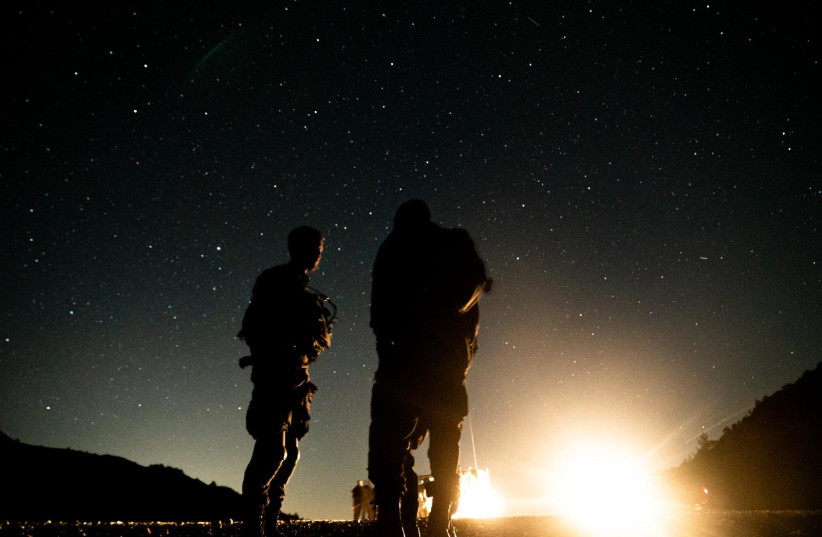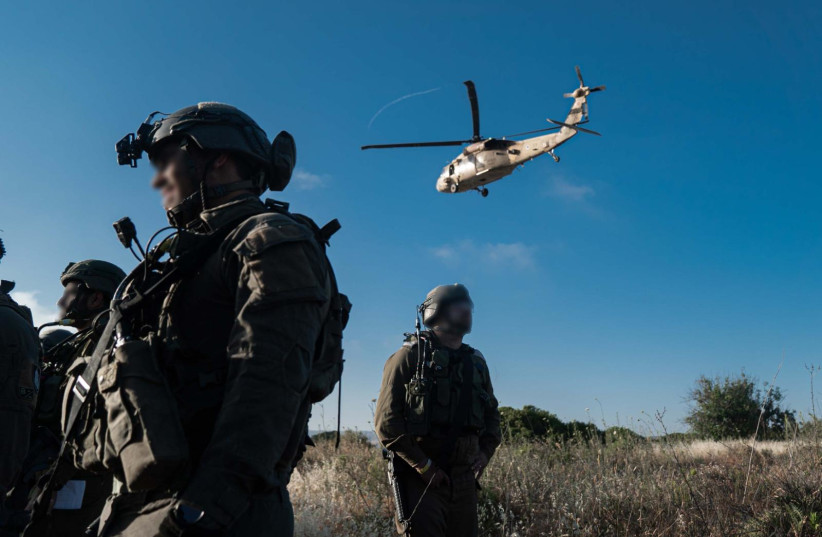CYPRUS – In the dead of night, thousands of IDF troops and reservists boarded C-130 transport aircraft and missile ships and headed to confront an enemy against which Israel has been training for years: Hezbollah.
Directed by officers sitting in the “Bor” underground command center at the IDF’s Kirya Military Headquarters in Tel Aviv, hundreds of vehicles, ships, and Israel Air Force aircraft joined the forces as they landed several hours later and headed to battle.
Soldiers ran through the narrow winding streets in villages on the mountainside, and combat helicopters were in the air along the coastline to give fire support as needed.
Teams from the Paratroopers Brigade elite Reconnaissance unit and the Oketz K9 unit identified Hezbollah militants in one abandoned building and engaged the enemy in order to destroy their infrastructure.
“Fire! Fire! We are taking incoming fire!” soldiers yelled as bullets whizzed by them.

Running up stairs full of broken glass, troops went after enemy forces.
“RPG!” yelled another soldier as a Hezbollah terrorist fired a shoulder-launched rocket-propelled grenade at the force as they tried to retake the building that had once been home to several families. Unarmed civilians even walked through the firefight, challenging IDF troops to make sure they would remain unharmed.
It took several hours of heavy fighting, and dozens of troops were injured, but the IDF regained control of the area.
Later that night another force was given a mission to capture another enemy target that they had obtained using real-time intelligence capabilities. Troops went deep into the mountains and several soldiers were wounded. With heavy fire directed at the site, the force had to wait several hours until they could evacuate the wounded.
During the week-long battle, IDF troops maneuvered dozens of kilometers into enemy territory. But the battle saw numerous soldiers captured, more missing in action and several IAF planes crashed. Thousands of enemy forces were also killed, as well as civilians.
But this didn’t take place in Lebanon – it was on the island nation of Cyprus.
It was all a drill, the final week of the IDF’s month-long Chariots of Fire exercise.
In close to two decades since Israel last fought Hezbollah, the terror group has transformed into a terror army and has gained battlefield experience fighting for the regime of Bashar Assad in Syria.

The group is believed to have 2,000 drones, an arsenal estimated at 150,000 rockets and missiles including several dozen precision missiles, and a battle-hardened fighting force of 40,000 men, including elite Radwan forces, established to carry out covert operations against Israel.
Though the military does not expect a war in the near future, the IDF wants its troops to be ready to maneuver deep inside Lebanon when the order is given, to destroy enemy infrastructure and bring Hezbollah to its knees.
Should war break out, the military knows that it will not be able to rely solely on the air force, and will need to use its ground troops to neutralize Hezbollah and its capabilities in villages in south Lebanon.
But the IDF had not conducted a full and proper ground maneuver in enemy territory since troops entered Gaza in 2014 during Operation Protective Edge. Lebanon’s topography gives Hezbollah the advantage over Israel.
And with many troops and officers never having experienced combat, the IDF has to train its forces for aggressive maneuvering deep inside enemy territory.
Beyond the Horizon
Since the terrain of Cyprus is similar to northern Israel and south Lebanon, the Israeli military sent thousands of troops to the island for a week of training dubbed “Beyond the Horizon” that caps off “Chariots of Fire.”
With the IDF trying to make the drill as realistic and challenging as possible, the unfamiliar mountainous terrain was the perfect location for IDF troops to train for an eventual war with Iran’s strongest and well-armed proxy.
“This is more challenging than back in Israel,” said one soldier in the Paratroopers Brigade taking part in the drill. “There are some things that make it tougher, and more believable here.”
The drill allowed troops to “work on challenges that you will really face during war, like being alone, independent, strong and of course beating the enemy,” said the commander of the IDF’s elite Yahalom combat engineering force.
With the drill taking place in terrain where troops have never been, “we prepared ourselves for the unknown,” he said. “We didn’t know what we were going to experience or what we would see, so we prepared for that. It’s a mental preparation for troops. They will experience something foreign and they have to contend with that.”
Yahalom unit members are responsible for advanced engineering reconnaissance, looking for and dismantling any possible IEDs (improvised explosive devices) before other forces move in, and locating and destroying tunnels that could be used by enemy troops to attack Israeli soldiers.
During the drill they were responsible for destroying vital infrastructure targets that belonged to enemy forces in close cooperation with commando units.
The exercise saw combat helicopters assist ground forces, perform emergency evacuations with IAF transport helicopters, direct and escort forces using visual intelligence and facilitate the movement of logistics equipment through the heavy transport squadrons.
Troops and dogs from the Oketz K9 unit that “constitute a force multiplier for maneuvering forces,” according to the army, located and identified various types of explosives devices, and located and attacked enemy soldiers in combat areas during the drill.
The IDF said in a statement that the goal of the drill was to improve the readiness of troops and their abilities to conduct missions “deep in enemy territory, while combining and maximizing multi-disciplinary capabilities.”
During the week-long intensive drill, the IDF built a whole military infrastructure on the island to provide logistics and command and control centers. Drones gave an aerial picture to troops and navy ships provided fire as well as logistical support.
Ships from the Hellenic Navy as well as from Italy also supported the IDF in the drill in Cyprus to transport logistics equipment and act as landing craft for fighters.
The Cypriot Army, which also sent forces to Israel, was able to learn from the IDF in terms of training and tactics. Nevertheless, critics of the drill said that having a foreign military on the island was dangerous as it gave Israel the advantage of knowing the territory of the island in depth.
The IDF believes that the alliance with countries in the Eastern Mediterranean such as Cyprus and neighboring Greece, gives Israel a strategic balance and helps to maintain stability against the threat posed by Iran and its proxies in the Middle East, including in Lebanon, Syria, Iraq and Yemen.
Cooperation between the two militaries has expanded in recent years and is viewed as a key component in maintaining the IDF’s operational readiness.
During a visit to the drill, Defense Minister Benny Gantz thanked Cyprus for hosting the IDF, saying that it “illustrates the depth of the strategic alliance between the two countries.” IDF Chief of Staff Lt.-Gen. Aviv Kohavi also thanked the Cypriot forces while visiting on Tuesday.
“I get the impression that the forces participating in the exercise, from all arms of the IDF, show very high levels of professionalism and readiness for action,” he said.
